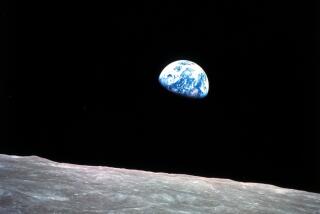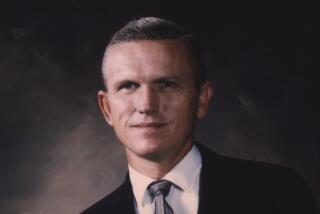The Doctor Behind Shepard’s Apollo 14 Flight
- Share via
Astronaut Alan Shepard, the first American in space and the first man to play golf on the moon, never forgot that Dr. William House of Newport Beach helped him get there.
House performed delicate ear surgery on Shepard, allowing him to return to space in 1971. The famed astronaut’s expression of thanks made House a historical footnote in the NASA space program. A small footnote, certainly, but one that has since been chronicled by producer-actor Tom Hanks in his HBO space anthology broadcast a few months ago.
Shepard, who died Tuesday at age 74, wrote in his own book, “Moonshot,” that House “was as great a man as he was a surgeon.” House, also 74, reminisced with me this week about how he and Shepard became friends. . . .
Shepard was one of the Mercury 7, America’s original astronauts. He catapulted ahead of the other six when he was chosen to become the country’s first man in space on May 5, 1961. His 15 minutes of suborbital flight led to America’s love affair with the idea of landing on the moon.
We heard little about Shepard, however, the next few years as other astronauts, such as John Glenn and Neil Armstrong, became household names. Shepard was relegated to an important but rather unglamorous desk job as chief of the Astronaut Office. Shepard had been taken off the ready-for-flight list because of an infection in his left ear that greatly bothered him for as much as five years. It was known as Meniere’s syndrome, a build-up of fluid in the inner ear. It not only affected Shepard’s hearing and balance, but kept him in pain. He was told he would never fly again.
But a fellow astronaut, Tom Stafford, told Shepard in 1968 that he had heard from one of the NASA doctors that an ear, nose and throat specialist in Los Angeles had developed a surgical procedure to treat Meniere’s syndrome.
That was House.
Today, surgery for Meniere’s syndrome is commonplace. But 30 years ago, House was one of the few who had written on the subject and who could perform such operations.
House recalls that Shepard “was highly personable, easy to like. But there was an intensity too. He was determined to get back into space.”
According to Shepard’s book, his response, after House explained the procedure to him, was, “Sounds like a hell of an idea to me. Let’s do it.”
Shepard wrote that he first discussed it with his wife, Louise: “The doctor can’t promise he’ll be successful. But I’m burning up inside, Louise. I want so badly to fly again in space. I’m willing to try anything.”
Shepard, who demanded secrecy to avoid media attention, entered St. Vincent’s Hospital in Los Angeles under the name Victor Poulos. It was a name made up by one of House’s nurses.
The surgery was highly successful; Shepard’s hearing returned completely over the next few months.
It took two years of medical scrutiny before NASA doctors would clear him to return to space. When they did, Shepard immediately lobbied to get command of Apollo 13, scheduled for 1970. For a brief period, he was assigned to command that lunar mission. But NASA leaders cautiously decided to postpone Shepard’s flight to Apollo 14 the next year. (Apollo 13 in 1970, you’ll recall, is the one that almost never made it back.)
Shepard hadn’t forgotten his new friend, Dr. William House. House and his wife, June, were invited to the VIP viewing area at Cape Kennedy for Apollo 14’s launching on Jan. 31, 1971.
“We were close to a mile away, yet you could feel the ground rumble when the blastoff came,” House said. “Afterwards, it took us about 45 minutes to get back to our hotel. By the time we got there, Alan had already orbited the Earth twice. That was pretty amazing to us.”
Shepard’s invitation went well beyond the launch. House and his wife then flew to NASA headquarters in Houston, the control center for the mission. House not only had complete access to the center, leaders there put him on the telephone so he could talk to Shepard as he and his two crew members headed to the moon.
House recalled their conversation: “Alan told me, ‘I’m talking to you through the ear that you operated on.’ The rest of the conversation was just chitchat, but I got a real kick out of it. Later my wife said, ‘Wow, that must be quite a phone bill.’ ”
That phone call between the two new friends was included in Tom Hanks’ re-creation of the Apollo 14 flight during one of the HBO specials.
“It was kind of a thrill seeing an actor play me,” House said with a laugh. “I really think I was better-looking than him, though.”
The Houses stayed in Houston for nine days, delightfully laughing with the rest at the command center as Shepard became the first lunar golfer.
The Shepards and Houses stayed in touch after that. When the Houses not long ago sent the Shepards a card on their 50th wedding anniversary, Shepard wrote back a kind note thanking him for helping him to return to space: “I could not have made it without you.”
*
Jerry Hicks’ column appears Tuesday, Thursday and Saturday. Readers may reach Hicks by calling the Times Orange County Edition at (714) 966-7823 or by fax to (714) 966-7711, or e-mail to jerry.hicks@latimes.com
More to Read
Sign up for Essential California
The most important California stories and recommendations in your inbox every morning.
You may occasionally receive promotional content from the Los Angeles Times.













